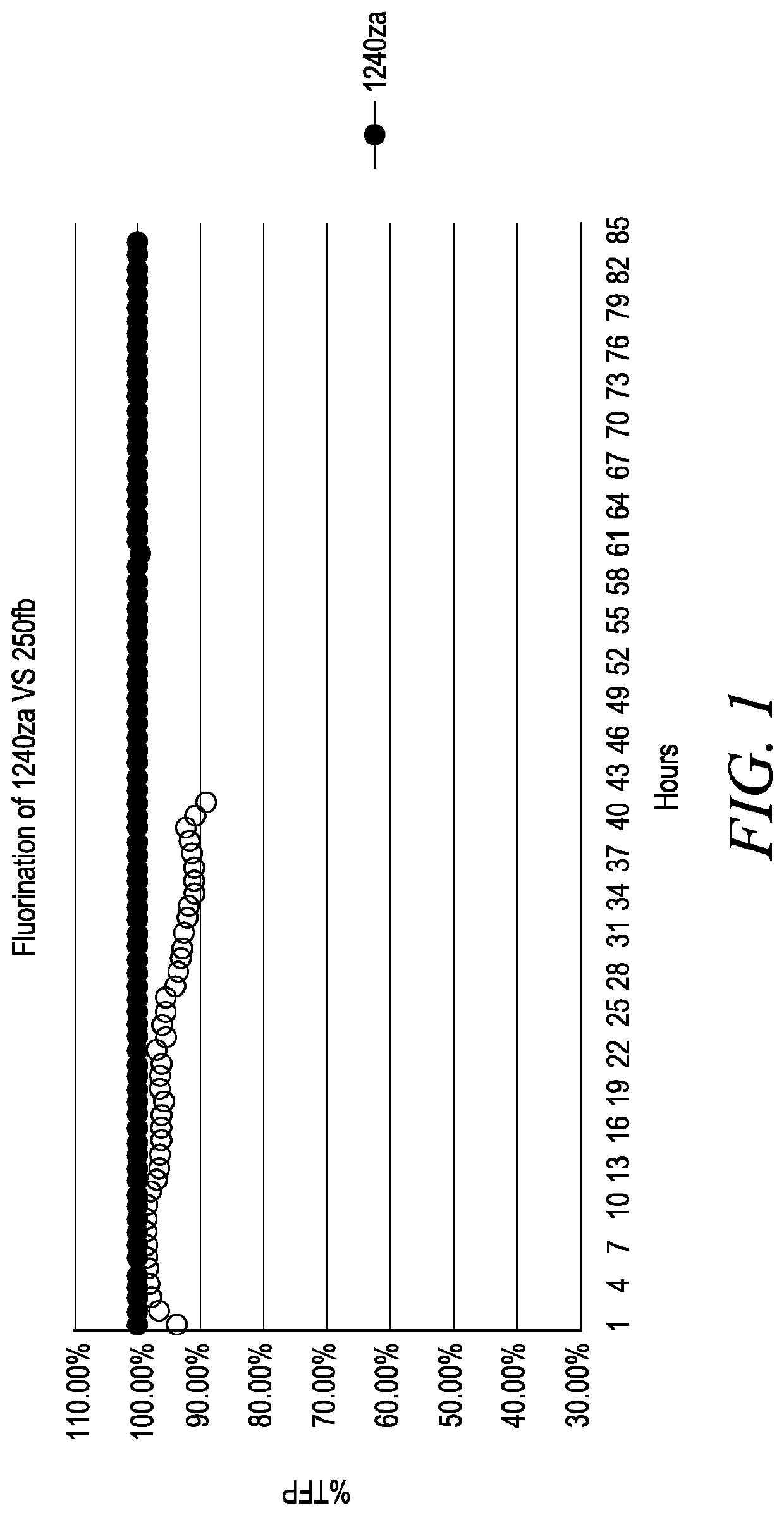Compositions and methods for an integrated 2,3,3,3-tetrafluoropropene manufacturing process
a technology of tetrafluoropropene and manufacturing process, which is applied in the field of compositions and methods of synthesis of hydrofluoroolefins, can solve problems such as damage to the earth's ozone layer, and achieve the effect of improving selectivity and yield
- Summary
- Abstract
- Description
- Claims
- Application Information
AI Technical Summary
Benefits of technology
Problems solved by technology
Method used
Image
Examples
example 1
[0077]Into a Hastelloy tube (12″ by ½″) was added 6 cc of 10% Cr / AC catalyst (12-20 mesh). The catalyst bed was purged with 30 standard cubic centimeters per minute (sccm) of nitrogen (N2) and the temperature was set at 150° C. for 2 hours and 250° C. for 2 hours. The temperature was decreased to 200° C., the N2 flow was changed to 60 sccm and anhydrous HF flow was fed at 20 sccm for 1 hour. Then the temperature was set at 250 and 300° C. each for 1 hour. While at 300° C., the N2 and HF flows were changed to 20 and 30 sccm respectively for 1 hour. Then the HF flow was changed to 48 sccm and the temperature was changed to 325° C. for 2 hours. The N2 flow was then stopped and the HF flow was maintained at 48 sccm for 1 hour to complete the catalyst activation.
example 2
1,1,3-trichloro-1-propene (1240za) Conversion to 3,3,3-trifluoro-1-propene (1243zf)
[0078]1240za was fed using a syringe pump at about 0.2 cc / hr and HF was fed using a mass flow controller at about 12.5 sccm. The organic and HF streams were mixed in a vaporizer heated at 150° C. prior to entering the reactor. The reaction was run at 300° C. and atmospheric pressure. Analysis of samples were performed by direct injection of the product stream onto an Agilent 7890A GC quipped with a 5975C MS. The gas chromatography column used to analyze the product stream was a 20 meter×⅛″ Krytox® column from Restek®.
example 3
1,1,1,3-tetrachloropropane (250fb) Conversion to 3,3,3-trifluoro-1-propene (1243zf) (Comparative)
[0079]250fb was fed using a syringe pump at about 0.2 cc / hr and HF was fed using a mass flow controller at about 12.5 sccm. The organic and HF streams were mixed in a vaporizer heated at 150° C. prior to entering the reactor. The reaction was run at 300° C. and atmospheric pressure. Analysis of samples were performed by direct injection of the product stream onto an Agilent 7890A GC quipped with a 5975C MS. The gas chromatography column used to analyze the product stream was a 20 meter×⅛″ Krytox® column from Restek®.
PUM
| Property | Measurement | Unit |
|---|---|---|
| Temperature | aaaaa | aaaaa |
| Temperature | aaaaa | aaaaa |
| Fraction | aaaaa | aaaaa |
Abstract
Description
Claims
Application Information
 Login to View More
Login to View More - R&D
- Intellectual Property
- Life Sciences
- Materials
- Tech Scout
- Unparalleled Data Quality
- Higher Quality Content
- 60% Fewer Hallucinations
Browse by: Latest US Patents, China's latest patents, Technical Efficacy Thesaurus, Application Domain, Technology Topic, Popular Technical Reports.
© 2025 PatSnap. All rights reserved.Legal|Privacy policy|Modern Slavery Act Transparency Statement|Sitemap|About US| Contact US: help@patsnap.com



